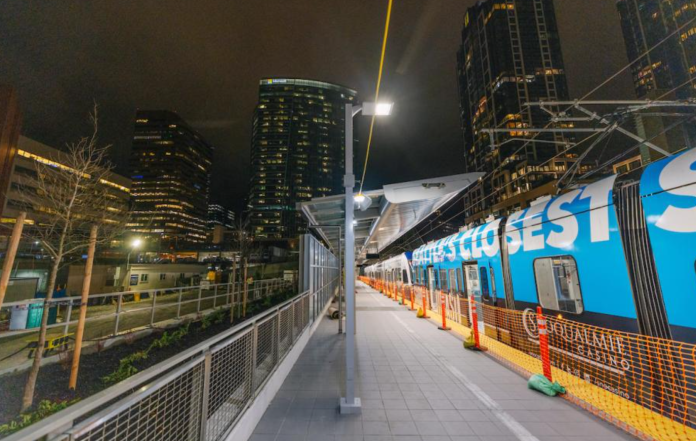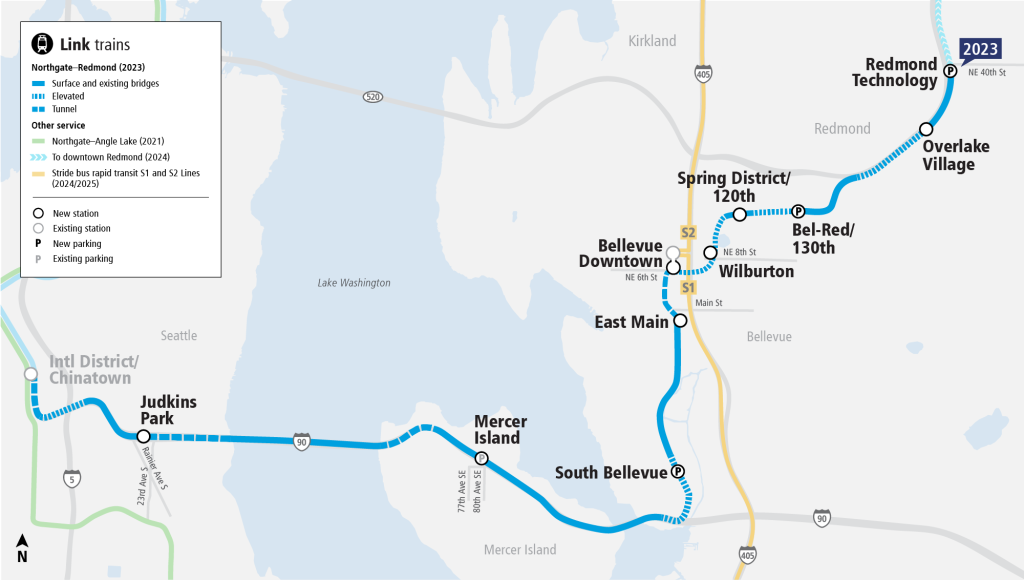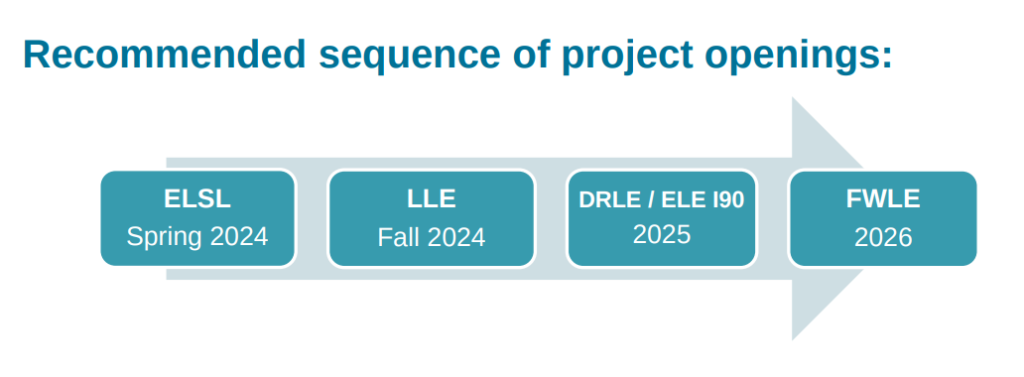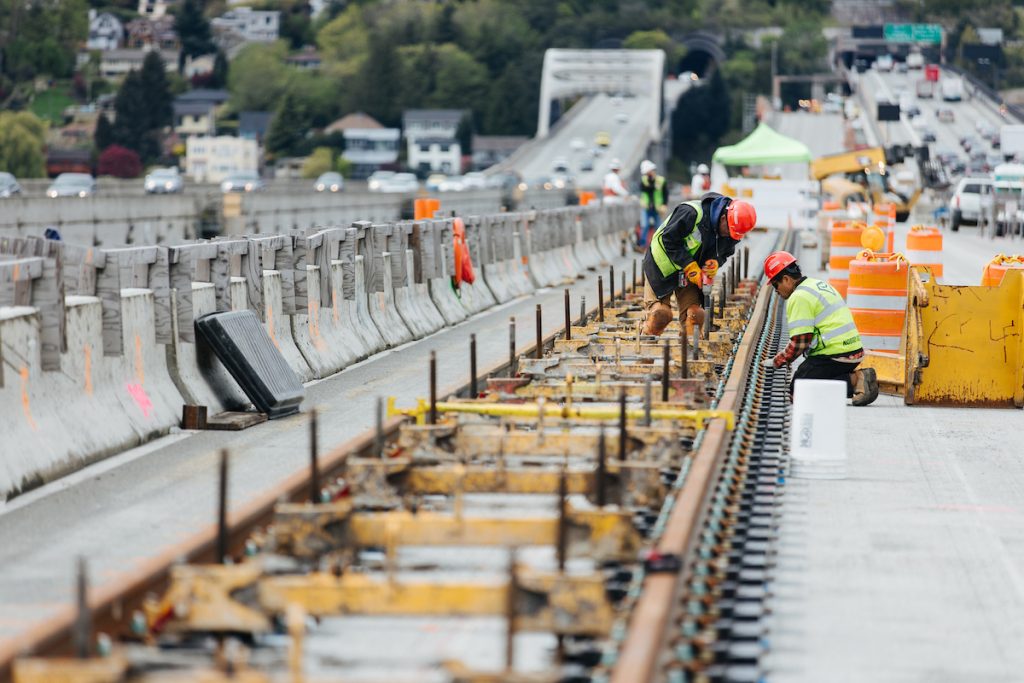
Light rail connecting Bellevue and Redmond is slated to open in spring 2024 following Sound Transit’s starter line decision.
Sound Transit was officially given the go-ahead to move forward with a plan to begin light rail service between eight isolated stations on the Eastside in spring of next year, after a vote by the agency’s System Expansion committee Thursday. The East Link Starter Line, as it’s called, was developed as an interim way to provide at least a partial level of service along the ten station East Link light rail extension while Sound Transit works to complete work on the I-90 floating bridge after defective work was found and announced publicly in 2022. The entire line had previously been planned to open in 2023.
Two-car trains will operate along the length of the Starter Line for 16 hours per day, a shorter span of service than along the existing 1 Line between Angle Lake and Northgate stations. Sound Transit expects around 6,000 people to board the Starter Line on an average weekday, compared to an initial forecast for the entire East Link line of 43,000 to 56,000 riders by 2026. The motion to move forward with opening the Starter Line still needs to be approved by Sound Transit’s full board on August 24th, but a unanimous vote in committee this week suggests that approval isn’t in doubt.
“This concept of opening up a portion of our light rail system, that is disconnected from the rest of the light rail system for a period of time, is unusual,” King County Councilmember Claudia Balducci, chair of the System Expansion committee, said ahead of the vote. “Unfortunately, this is nobody’s first choice, certainly not mine…but our choices are to wait for a significant and possibly as yet still-uncommitted period of time until the [I-90] bridge opens, or to put to use the very significant and really great infrastructure that has been built in east King County.”
An Eastside Starter Line probably wouldn’t have happened without pushing from local electeds, with Balducci principally among them. Last summer, Balducci pitched the idea on the heels of the I-90 bridge setback, and the idea quickly snowballed from there, with mobility advocates on the Eastside taking the idea and running with it.

“The East Link Starter Line represents access to frequent, reliable transit service on the Eastside,” Kelli Refer, the Executive Director of Move Redmond, told The Urbanist. “This line also delivers transit to two communities who have made an investment in Transit-Oriented Development like the Spring District and Overlake Village, where people are moving into new housing every day and anxiously awaiting the opening of light rail. Furthermore, this approach shows that Sound Transit is able to be nimble in the face of setbacks and value transit riders’ time by opening the stations as soon as possible.” (Full disclosure: Refer is a member of The Urbanist’s board)
Although trains have already been spotted occasionally running along the length of the Starter Line, observers should notice an uptick in service after November 1, when Sound Transit says it currently expects to enter pre-revenue service, during which time light rail operators start to substantially test how the system operates with live trains. Out of 180 positions needed to fully staff the Starter Line, Sound Transit says, 82% have already been filled, with around 15 new light rail operators being hired per month through its agreement with King County Metro.
Balducci touted the real benefits that starting East Link service early will provide to riders. “We can start to get practice using the system, people riding on the system,” she said. “It does connect significant locations to one another, and in connection via bus to the rest of the system, even though not connected via rail to the rest of the system as yet.” On Monday, Sound Transit opened a brand new bus loop at Redmond Technology Center, the north terminus of the Starter Line. That facility, currently in use by Microsoft Connector buses only but set to be used by transit agency buses this fall, will provides a seamless bus connection to light rail and illustrates the types of connections that would remain underutilized if the Starter Line was not moving forward.

Starter Line Opening Sets Off A Long String of Planned Light Rail Openings
On Thursday, Sound Transit staff described a “regular cadence” of system segment openings that would commence with the start of East Link Starter Line service next spring. Lynnwood Link, which includes four stations north of Northgate Station as part of the Central Link 1 line, will follow quickly on the heels of the Eastside Starter line in fall of 2024. After that, the rest of East Link as well as an extension to downtown Redmond would open in 2025, followed by the extension to the south end of the 1 line to Federal Way in 2026.

These openings will be officially approved by the board later this year as part of the agency’s annual service plan. If approved, they will prove to be a big test of Sound Transit’s ability to manage a long string of high profile segment openings while managing the high-wire act of light rail vehicle storage and operator availability. A delay in one segment’s opening has the potential to cascade and impact other segments.
Despite what appears to be a direct trade-off between opening an East Link Starter Line and opening Lynnwood Link, the real constraints for Lynnwood Link are happening independent of the Starter Line and stem more from Sound Transit not having access to its Bellevue Operations and Maintenance facility while the I-90 bridge remains unavailable to carry trains. Fleet storage constraints mean that until the bridge opens, Sound Transit won’t have enough space to store light rail vehicles to achieve the desired 8-minute service levels on Lynnwood Link, no matter how many trains are running on the Eastside. Right now, Sound Transit is set to commence service on Lynnwood Link with a mix of three and four-car trains, though the exact mix is yet to be determined. Given the high demand for service along even the currently open stations, this creates a high likelihood of overcrowding.

Balducci offered a note of vigilance in her remarks Thursday, even while celebrating the fact that the Starter Line was moving forward. If Sound Transit was put in a position where resources need to be diverted from the Starter Line to ensure that Lynnwood Link and service down to Angle Lake operates at full capacity, that may be what happens. “The 1 line, the main line of our system is where the heavy ridership will be for the foreseeable future, and we need to prioritize that, and I believe that we can do both,” she said.
Ryan Packer has been writing for The Urbanist since 2015, and currently reports full-time as Contributing Editor. Their beats are transportation, land use, public space, traffic safety, and obscure community meetings. Packer has also reported for other regional outlets including BikePortland, Seattle Met, and PubliCola. They live in the Capitol Hill neighborhood of Seattle.

